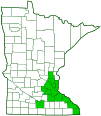bordered wedge-shaped beetle
(Macrosiagon limbata)
Conservation • Description • Habitat • Ecology • Distribution • Taxonomy
|
|
||||||||||||||
Description |
Bordered wedge-shaped beetle is a common and widely distributed, parasitic beetle. It occurs in eastern North America west to Arkansas and in Central and South America. Adults are black and orange, slender, and 3 ⁄16″ to ½″ (5 to 12 mm) long. The head is elongated, directed downward, and mostly orange. It is strongly constricted behind the eyes. The upper surface (vertex) is black, hairless, rounded, and distinctly elevated above the front (anterior) margin of the upper thoracic plate (pronotum). The upper part of the face (frons) is smooth. The upper part of the mouth (labrum), corresponding to the upper lip, is elongated and rounded at the tip. The pair of chewing structures on the mouth (mandibles) are moderately curved. They are mostly black but orange at the base. There are two small, black, oval, prominent, compound eyes and no simple eyes (ocelli). The antennae are black except for the first two segments, which are orange. The base of each antenna is near the middle of the inner margin of the eye. On the female they are deeply sawtoothed. On the male they are shorter than the pronotum and are comb-like, with dense, thick, long projections on both sides of each antenna segment (biflabellate). The projections on both sides are usually pointed forward, making the antennae appear one-sided (flabellate). The pronotum is longer than the base is wide, and slightly tapers toward the front. It is orange and has a black spot that is variable in size. It does not have a sharp lateral ridge or a distinct suture. The base has sharp, prolonged, acutely angled corners and a large triangular lobe in the middle that covers the plate over the wing bases (scutellum). The hardened forewings (elytra) are long, slightly tapered toward the end, and entirely dark brown to black. They extend well beyond the end of the abdomen. For most of their length they do not touch each other but are separated like an inverted v, exposing the brown hindwings. The legs are long and slender. The third segment of each leg (femur) is orange with a black tip. On the front legs the femur is indented at the tip. On the hind legs the femur is distinctly compressed. The fourth segment (tibia) on the front legs is entirely black. On the middle and hind legs it is usually orange on the basal half, black on the apical half, sometimes entirely black. On the front and middle legs, the last part of the leg (tarsus), corresponding to the foot, is black and has five segments. On the hind leg it has only four segments. The inner surface is smooth and hairless. The second tarsal segment on the hind leg is flat, shiny above, and about half as long as the third segment. There is a pair of claws at the end of each tarsus. Each claw is split in two. |
Size |
Total length: 3 ⁄16″ to ½″ (5 to 12 mm) |
Similar Species |
Habitat |
|
Ecology |
Season |
June to August |
Behavior |
|
Life Cycle |
The female lays eggs on flowers. When an egg hatches, the first stage larva (triungulin) attaches itself to the underside of a solitary bee or wasp. After it is carried back to the host’s nest, the triungulin invades the cell of a host larva and enters into the body of the larva. It then delays further development while the host matures. When the host larva is completely developed, the triungulin exits the larva’s body and consumes it and its stored food. |
Larva Food |
Larvae of wasps and bees |
Adult Food |
Flower nectar |
Distribution |
||
|
Sources |
|
| 7/6/2025 | ||
Occurrence |
||
|
||
Taxonomy |
|
Order |
Coleoptera (Beetles) |
Suborder |
Polyphaga (Water, Rove, Scarab, Long-horned, Leaf, and Snout Beetles) |
Infraorder |
Cucujiformia |
Superfamily |
Tenebrionoidea (darkling beetles and allies) |
Family |
Ripiphoridae (wedge-shaped beetles) |
Subfamily |
Ripiphorinae |
Genus |
Macrosiagon |
Older and even relatively recent printed literature refer to this species as Macrosiagon limbatum. Some online sources do so as well, including GBIF and NaturServe. The grammatical gender of the genus Macrosiagon is feminine. Therefore, the species epithet needs to be in the feminine form as well. Limbatum is the neuter form, while limbata is the feminine form. |
|
Subordinate Taxa |
|
|
|
Synonyms |
|
Macrosiagon limbatum |
|
Common Names |
|
|
|
Glossary
Elytra
The hardened or leathery forewings of beetles used to protect the fragile hindwings, which are used for flying. Singular: elytron.
Femur
On insects and arachnids, the third, largest, most robust segment of the leg, coming immediately before the tibia. On humans, the thigh bone.
Frons
The upper front part of an insect’s face, roughly corresponding to the forehead.
Labrum
The upper part of the mouth, sometimes considered the lower part of the face, corresponding to the upper lip, on an insect or crustacean.
Ocellus
Simple eye; an eye with a single lens. Plural: ocelli.
Pronotum
The exoskeletal plate on the upper side of the first segment of the thorax of an insect.
Scutellum
The exoskeletal plate covering the rearward (posterior) part of the middle segment of the thorax in some insects. In Coleoptera, Hemiptera, and Homoptera, the dorsal, often triangular plate behind the pronotum and between the bases of the front wings. In Diptera, the exoskeletal plate between the abdomen and the thorax.
Tarsus
On insects, the last two to five subdivisions of the leg, attached to the tibia; the foot. On spiders, the last segment of the leg. Plural: tarsi.
Tibia
The fourth segment of an insect leg, after the femur and before the tarsus (foot). The fifth segment of a spider leg or palp. Plural: tibiae.
vertex
The upper surface of an insect’s head.
Visitor Photos |
||
Share your photo of this insect. |
||
This button not working for you? |
||
Mike Poeppe |
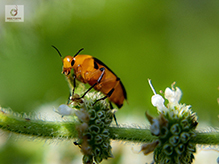 |
Alfredo Colon |
||
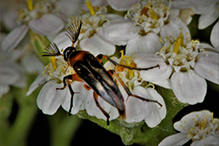 |
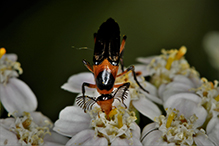 |
|
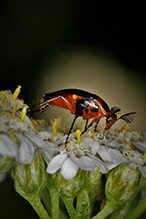 |
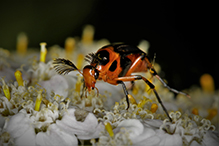 |
|
MinnesotaSeasons.com Photos |
||
|
||
|
||

Slideshows |
|

Visitor Videos |
||
Share your video of this insect. |
||
This button not working for you? |
||
|
Other Videos |
||
Wedged shaped beetle forages on hoary mountain mint |
About
Published on Jul 22, 2012 A wedged-shaped beetle, Macrosiagon limbata (Coleopytera; Ripiphoridae) forages for nectar on hoary mountain-mint, Pychnanthemum incanum (Lamiaceae) July 22, 2012 in Hocking County, Ohio, USA. |

Created: 12/12/2018 Last Updated: © MinnesotaSeasons.com. All rights reserved. |
